Soups and Stocks
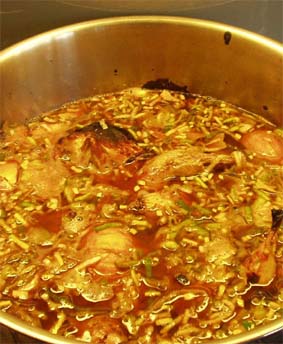 Family tradition is one of the most beautiful aspects of cooking. Sharing recipes and methods of preparation down through generations, has become one of the most creative ways for the home cook to create a niche for themselves in the kitchen. I know for me, when the words "Grandma Meal" come to mind, my eyes and palate light up with comfort and excitement! This family tradition is a fairly simple split pea soup with a ton of flavor and aromatics developed from hours and hours of cooking. Grandma (or Beeba as I’ve called her since I was a baby) makes it a couple of times a year and freezes it for the family to have
Family tradition is one of the most beautiful aspects of cooking. Sharing recipes and methods of preparation down through generations, has become one of the most creative ways for the home cook to create a niche for themselves in the kitchen. I know for me, when the words "Grandma Meal" come to mind, my eyes and palate light up with comfort and excitement! This family tradition is a fairly simple split pea soup with a ton of flavor and aromatics developed from hours and hours of cooking. Grandma (or Beeba as I’ve called her since I was a baby) makes it a couple of times a year and freezes it for the family to have 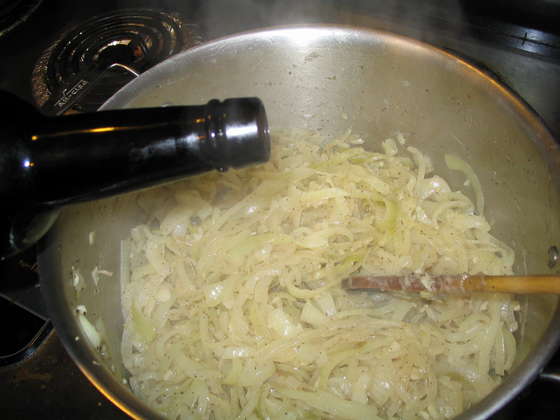 anytime we are in town. The traditions, like this soup, are what have made me realize that it takes a lot of love, experience, and good ingredients to create great soups and stocks.
anytime we are in town. The traditions, like this soup, are what have made me realize that it takes a lot of love, experience, and good ingredients to create great soups and stocks.
Most soups start with some type of broth or stock which is defined as a liquid (usually water) that is fortified with a definite flavor. Different types of stocks include, vegetable, chicken, beef, duck, fish, lobster, corn, asparagus, etc… the list is endless depending on what flavor you are looking for, and what you are going to use it in. The final flavor you are trying to achieve determines how you are going to treat the ingredients going into your stock. For example; corn stock vs. roasted corn stock.
Developing flavor is an important part of a successful soup or stock, and that can be achieved in many ways. If the home cook wants to make a meaty and rich soup, it is important to caramelize 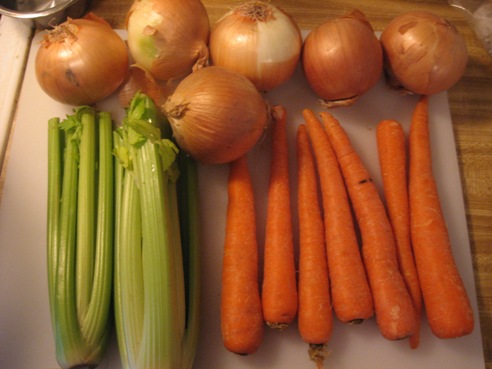 the meat and vegetables first, then ‘deglaze’ the pan with a liquid (sometimes red or white wine) to remove the flavorful pieces from the bottom of the pan, and add those flavors to the soup.
the meat and vegetables first, then ‘deglaze’ the pan with a liquid (sometimes red or white wine) to remove the flavorful pieces from the bottom of the pan, and add those flavors to the soup.
A French term called ‘Mirepoix,’ is the foundation of most soups and stocks. This is a mixture of 2 parts onion, 1 part carrot, and 1 part celery. 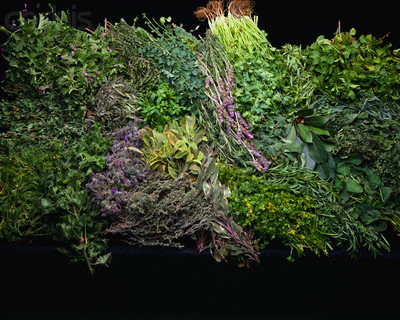 Aromatics are flavor enhancers that are added to your stock to bloom or boost flavors. Aromatics include: peppercorns, bay leaves, juniper berries, any herbs, any onions, or garlic.
Aromatics are flavor enhancers that are added to your stock to bloom or boost flavors. Aromatics include: peppercorns, bay leaves, juniper berries, any herbs, any onions, or garlic.
Most importantly, we need to determine what type of stock we want to create, and then decide what the future of our beautiful stock will be. After you have added all your ingredients you are now ready to let your stock simmer. A simmer is a temperature 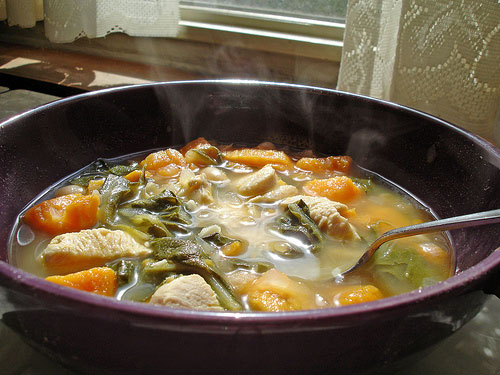 between 190-200 degrees and different stocks have different simmering times:
between 190-200 degrees and different stocks have different simmering times:
Vegetable stocks~45 minutes
Fish stocks~1 hour 30 minutes
Chicken (Poultry) stocks~2 hours
Beef (Large Boned Animal) stocks~6 hours (normally pre-roast the bones)
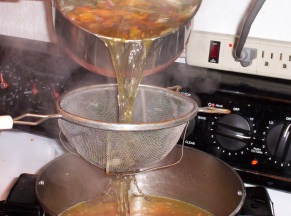 The final step is straining your stock properly. All that you are looking for is the pure, beautiful liquid you just fortified, and need to pass it through a strainer or "cheesecloth" to remove all impurities and vegetables. Now your stock is ready to be turned into a soup or sauce.
The final step is straining your stock properly. All that you are looking for is the pure, beautiful liquid you just fortified, and need to pass it through a strainer or "cheesecloth" to remove all impurities and vegetables. Now your stock is ready to be turned into a soup or sauce.
Soup is a food that is made by combining ingredients such as meat and vegetables in stock or hot/boiling water, until the flavor is extracted, forming a broth. Traditionally, soups are classified into two broad groups: clear soups and thick soups. The established French classifications of clear soups are bouillon and consommé. Thick soups are classified depending upon the type of thickening agent used: purées are vegetable soups thickened with starch; bisques are made from puréed shellfish thickened with cream; cream soups are thickened with béchamel sauce; and veloutes are thickened with eggs, butter and cream. Other ingredients commonly used to thicken 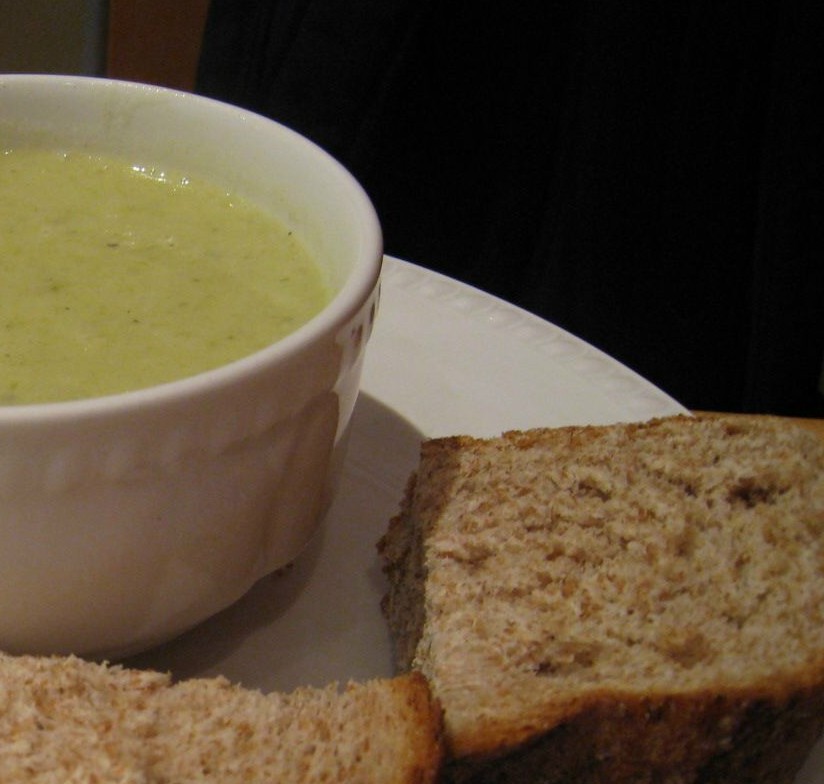 soups and broths include rice, flour, and grains. The word soup originates from "sop," a dish originally consisting of a soup or thick stew which was soaked up with pieces of bread. The modern meaning of sop has been limited to just the bread intended to be dipped.
soups and broths include rice, flour, and grains. The word soup originates from "sop," a dish originally consisting of a soup or thick stew which was soaked up with pieces of bread. The modern meaning of sop has been limited to just the bread intended to be dipped.
Cooking with the seasons can be a lot of fun, and although we don’t experience all 4 seasons to the fullest here in Florida, I still enjoy gathering ingredients that are at their peek of freshness. Autumn is by far my favorite season, and I enjoy making heartier soups such as butternut squash or a simple tomato-Parmesan with lentils and barley.
Below is a simple recipe for butternut squash soup. It should only take approximately 35 minutes to prepare, and the flavors are wonderful!
Butternut Squash Soup
1 butternut squash, peeled 1 onion, chopped
2 tsp nutmeg 2 tablespoons unsalted butter
Salt and pepper (to taste) 6 cups chicken stock
Method
Cut squash into 1-inch chunks. In a large pot melt butter. Add onion and cook until translucent, about 8 minutes.
 Add squash and stock. Bring to a simmer and cook until squash is tender.
Add squash and stock. Bring to a simmer and cook until squash is tender.
Remove squash chunks with slotted spoon and place in a blender and puree. You may have to add a bit of the cooking liquid to achieve the desired consistency.
Return blended squash to the pot. Stir and season with nutmeg, salt, and pepper.
To Plate
Garnishes for the soup may vary, you can make a cinnamon flavored crème fraiche, pumpkin croutons, or just garnish with chopped chives.
Good Luck and Good Eating!
~Chef Brian


